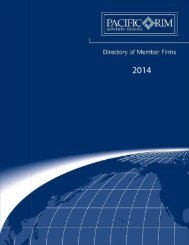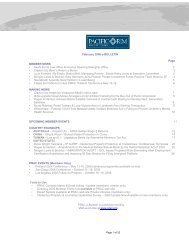A Guide to the Law of Securitisation in Australia - Clayton Utz
A Guide to the Law of Securitisation in Australia - Clayton Utz
A Guide to the Law of Securitisation in Australia - Clayton Utz
- No tags were found...
Create successful ePaper yourself
Turn your PDF publications into a flip-book with our unique Google optimized e-Paper software.
5 Taxation issues relevant <strong>to</strong> securitisation5.1 IntroductionThis section deals pr<strong>in</strong>cipally with four issues:• section 5.2 describes <strong>the</strong> general pr<strong>in</strong>ciples <strong>of</strong>Commonwealth <strong>in</strong>come taxation and <strong>the</strong>ir application <strong>to</strong>securitisation programs;• section 5.3 analyses <strong>the</strong> <strong>in</strong>terest withhold<strong>in</strong>g tax rules and<strong>the</strong> requirements that need <strong>to</strong> be complied with where an<strong>Australia</strong>n securitisation program seeks <strong>to</strong> issue securities <strong>to</strong>foreign <strong>in</strong>ves<strong>to</strong>rs;• section 5.8 describes <strong>the</strong> GST regime and highlights some <strong>of</strong><strong>the</strong> major areas for concern <strong>to</strong> securitisation programs; and• section 5.9 provides a summary <strong>of</strong> changes <strong>to</strong> <strong>the</strong> <strong>Australia</strong>ntax regime which have been foreshadowed as at <strong>the</strong> date <strong>of</strong>this publication.5.2 Income tax issues for securitisation programs5.2.1 OverviewIncome tax <strong>in</strong> <strong>Australia</strong> is currently levied under two Acts – <strong>the</strong>Income Tax Assessment Act 1936 (<strong>the</strong> 1936 Tax Act) and <strong>the</strong>Income Tax Assessment Act 1997 (<strong>the</strong> 1997 Tax Act). The 1997Tax Act is be<strong>in</strong>g progressively enacted and is essentially a rewrite<strong>of</strong> <strong>the</strong> 1936 Tax Act. The <strong>in</strong>tention is that <strong>the</strong> provisions <strong>of</strong> <strong>the</strong>1997 Tax Act express <strong>the</strong> same law as <strong>in</strong> <strong>the</strong> 1936 Tax Act but <strong>in</strong>a clearer style.One <strong>of</strong> <strong>the</strong> key concerns dur<strong>in</strong>g <strong>the</strong> structur<strong>in</strong>g phase <strong>of</strong> asecuritisation program is <strong>to</strong> ensure <strong>the</strong> tax neutrality <strong>of</strong> <strong>the</strong>securitisation vehicle (whe<strong>the</strong>r it is a corporation or a trust).5.2.2 Taxation issues relat<strong>in</strong>g <strong>to</strong> corporationsGeneral pr<strong>in</strong>ciplesWhere a special purpose corporation is used as a securitisationvehicle, <strong>the</strong> corporation is subject <strong>to</strong> <strong>the</strong> normal tax rulesapply<strong>in</strong>g <strong>to</strong> corporations.Deductions for losses and bad debtsAn issue which sometimes needs <strong>to</strong> be considered is <strong>the</strong> ability<strong>of</strong> a special purpose corporation <strong>to</strong> claim deductions for priorand/or current year losses and bad debts. This is particularlyimportant where <strong>the</strong> tax neutrality <strong>of</strong> <strong>the</strong> corporation dependsupon <strong>the</strong> availability <strong>of</strong> such deductions. Generally, <strong>the</strong> ability <strong>to</strong>claim such deductions depends upon <strong>the</strong> corporation pass<strong>in</strong>g a“cont<strong>in</strong>uity <strong>of</strong> ownership test” or, <strong>in</strong> certa<strong>in</strong> circumstances, a“cont<strong>in</strong>uity <strong>of</strong> bus<strong>in</strong>ess test”. The “cont<strong>in</strong>uity <strong>of</strong> ownership test”requires <strong>the</strong> trac<strong>in</strong>g <strong>of</strong> controll<strong>in</strong>g <strong>in</strong>terests <strong>in</strong> <strong>the</strong> corporationthrough <strong>in</strong>terposed entities and <strong>the</strong> application <strong>of</strong> <strong>the</strong> test canbecome a particularly complex task if shares are held (directly or<strong>in</strong>directly) <strong>in</strong> a corporation by discretionary or charitable trusts(which is <strong>of</strong>ten <strong>the</strong> case <strong>in</strong> securitisations).5.2.3 Taxation issues relat<strong>in</strong>g <strong>to</strong> trustsGeneral pr<strong>in</strong>ciplesTax will only be levied on <strong>the</strong> trustee <strong>of</strong> a trust where an<strong>Australia</strong>n resident beneficiary is not presently entitled <strong>to</strong> <strong>the</strong> net<strong>in</strong>come <strong>of</strong> <strong>the</strong> trust for tax purposes or where <strong>the</strong> trustee is taxedas a company for <strong>the</strong> purposes <strong>of</strong> Divisions 6B or 6C <strong>of</strong> <strong>the</strong> 1936Tax Act. <strong>Securitisation</strong> trusts are usually structured so that abeneficiary is entitled <strong>to</strong> any <strong>in</strong>come derived by <strong>the</strong> trust, with<strong>the</strong> <strong>in</strong>tended effect that <strong>the</strong> trustee will not be personally liablefor tax <strong>in</strong> respect <strong>of</strong> any <strong>in</strong>come derived by <strong>the</strong> trust.Where a securitised <strong>in</strong>strument is equity (ie. a unit <strong>in</strong> a unittrust), <strong>the</strong> taxation <strong>of</strong> any payments made will depend onwhe<strong>the</strong>r <strong>the</strong>se constitute redemptions <strong>of</strong> capital (which are notassessable) or distributions <strong>of</strong> <strong>in</strong>come (which are assessable).Also, <strong>in</strong> certa<strong>in</strong> circumstances, <strong>the</strong> trustee can be required <strong>to</strong>deduct tax from trust distributions <strong>to</strong> non-resident unit holdersand remit this directly <strong>to</strong> <strong>the</strong> Commissioner <strong>of</strong> Taxation.Taxation <strong>of</strong> trusteesOrd<strong>in</strong>arily, <strong>the</strong> account<strong>in</strong>g <strong>in</strong>come <strong>of</strong> a securitisation trust will be<strong>the</strong> same as <strong>the</strong> net <strong>in</strong>come <strong>of</strong> <strong>the</strong> trust for taxation purposes.However, <strong>in</strong> certa<strong>in</strong> circumstances, it is possible that <strong>the</strong>“net<strong>in</strong>come” <strong>of</strong> a trust for taxation purposes for an <strong>in</strong>come year mayexceed its account<strong>in</strong>g net <strong>in</strong>come, for example, where <strong>the</strong>account<strong>in</strong>g <strong>in</strong>come <strong>of</strong> a trust <strong>in</strong>cludes non-deductibleexpenditure. There are, basically, two conflict<strong>in</strong>g views as <strong>to</strong> how<strong>the</strong> excess over <strong>the</strong> account<strong>in</strong>g “net <strong>in</strong>come” is assessed.Under <strong>the</strong> quantum approach, <strong>the</strong> beneficiary could only beentitled <strong>to</strong> such amount <strong>of</strong> <strong>in</strong>come as he is entitled <strong>to</strong> receiveand, if <strong>the</strong> net <strong>in</strong>come <strong>of</strong> <strong>the</strong> trust exceeds <strong>the</strong> amount which heis entitled <strong>to</strong> receive, that excess is not <strong>in</strong>come <strong>to</strong> which <strong>the</strong>beneficiary is presently entitled and is assessable <strong>to</strong> <strong>the</strong> trustee.The proportionate approach regards <strong>the</strong> beneficiary’s share <strong>of</strong>account<strong>in</strong>g <strong>in</strong>come as only be<strong>in</strong>g relevant <strong>to</strong> determ<strong>in</strong><strong>in</strong>g thatbeneficiary’s share <strong>of</strong> <strong>the</strong> net <strong>in</strong>come <strong>of</strong> <strong>the</strong> trust for taxpurposes. The operation <strong>of</strong> <strong>the</strong> proportionate method may requireat least some <strong>in</strong>come <strong>to</strong> have been derived by <strong>the</strong> trust <strong>in</strong> <strong>the</strong>year <strong>of</strong> <strong>in</strong>come that is capable <strong>of</strong> be<strong>in</strong>g distributed <strong>to</strong> abeneficiary.29






